
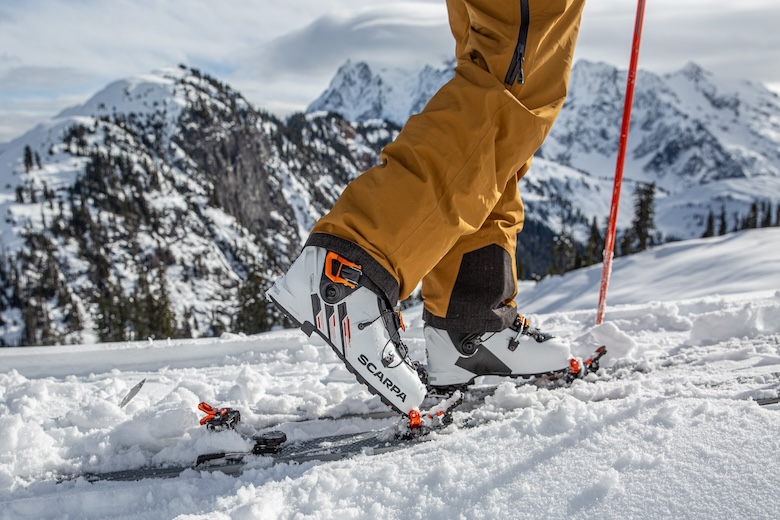
Switchback Travel (Brian McCurdy)
There's a strong argument that the most important part of your ski touring kit is a pair of quality boots that fit well. The good news is that this growing category has seen some impressive advancements, with a plethora of models that excel both on the climb and descent. Below are our top backcountry ski boot picks for the 2025 season, from lightweight builds for deep alpine exploring to downhill-oriented models that can hang at the resort too. Our editors put these boots to the test: we climbed Denali, skied narrow couloirs in the Sawtooths, ski guided over 150 days, and went on 20+ mile day missions to ski lines in Patagonia. For more background information, see our detailed buying advice and comparison table below the picks. And to complete your alpine touring setup, check out our articles on the best backcountry skis and backcountry ski bindings.
Editor's note: This guide was updated on November 1, 2024, to refresh our top picks and add our favorite new releases for the season from multiple brands. We also updated key areas of our buying advice and added more information about our testing process and team.
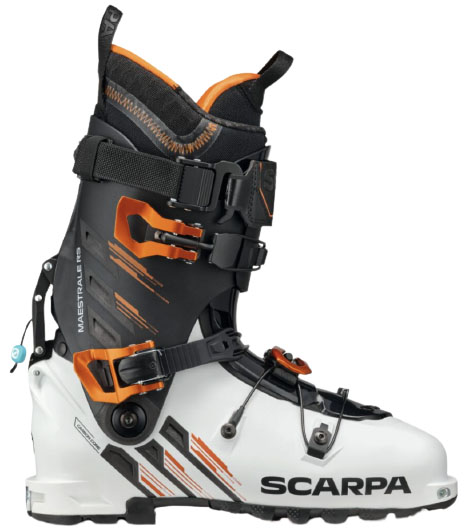 Category: All-around
Category: All-around
Weight per boot: 1460g
Flex: 125
Other flexes: 100W, 100, 125W
Range of motion: 60-degrees
What we like: Excellent performance on both the uphill and descent.
What we don't: Not burly enough and sole not compatible to be a top hybrid choice.
Many backcountry boots favor either uphill or downhill performance, but the Scarpa Maestrale RS has an impressive balance that earns it our top billing for the 2025 season. It's a standout on the skin track with a comfortable fit, lightweight construction, and 60-degree cuff rotation, which exceeds the ankle's range of motion. The boot does a fine impression of an alpine model with a progressive 125 flex that can be driven hard, and Scarpa didn't skimp on the liner either: The included Intuition Cross Fit Pro Flex Performance is a proven design that is warm, resists packing out, and can be heat-molded for a custom fit. To top it off, the Scarpa wave-closure system provides the precision of two buckles with half the bulk.
The Maestrale RS (and women’s Gea RS) was updated in 2024 with carbon inserts on the shell and cuff for improved torsional rigidity and power transfer from the legs to the skis. Scarpa also added a new Vibram sole for improved grippy walkability. But it’s still the Maestrale we know and love: The RS is compatible with a wide range of binding and crampon styles, sports a generous 102-millimeter last that accommodates most foot types, and its 125 flex rating is plenty sturdy for the vast majority of aggressive skiers. The main drawback is that its sole is not compatible with alpine bindings, unlike Scarpa's true hybrid offering, the 4-Quattro XT below. For a step down, Scarpa also makes a standard Maestrale, which is $100 less and boasts a 110 flex rating.
Read more: Scarpa Maestrale RS review
See the Men's Scarpa Maestrale RS See the Women's Scarpa Gea RS
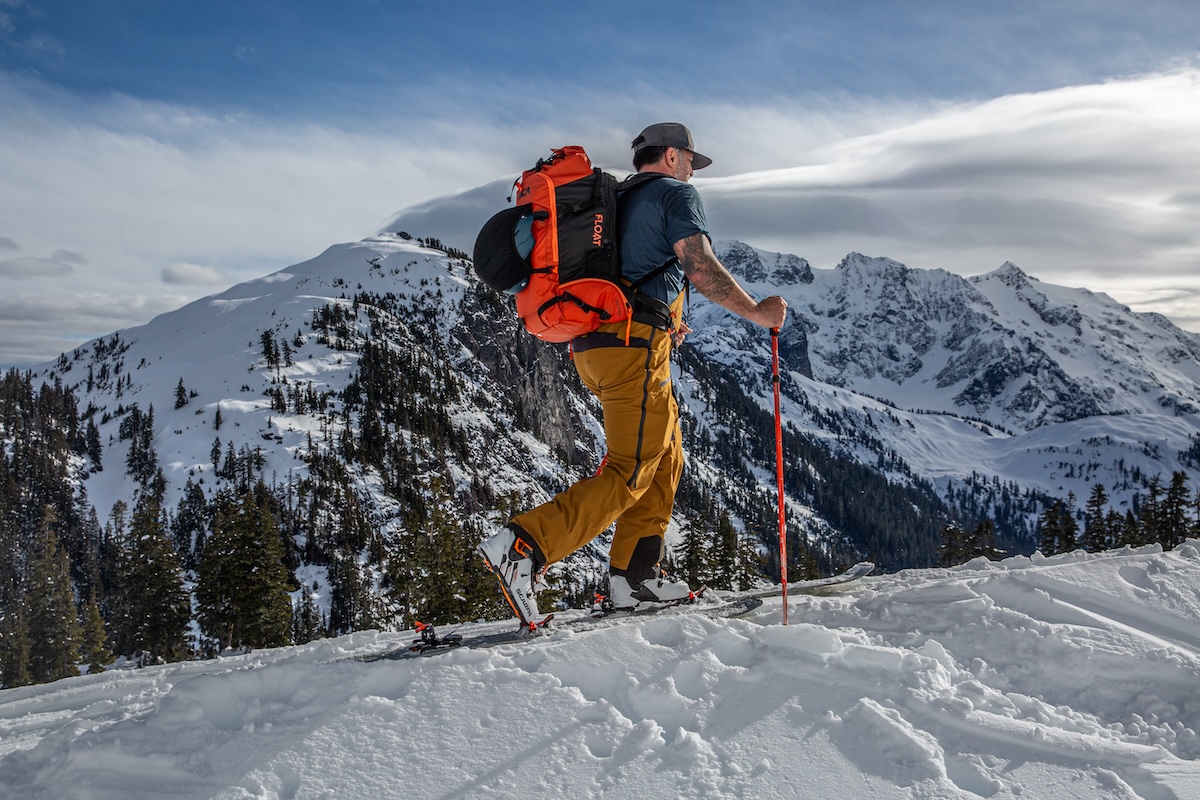
 Category: Hybrid
Category: Hybrid
Weight per boot: 1796g
Flex: 100
Other flexes: 95W, 105W, 110, 115W, 120, 125W, 130, 140
Range of motion: 50-degrees
What we like: Solid entry-level backcountry boot at a great price.
What we don’t: Not for long-reaching tours.
Touring boots are undeniably expensive, but K2’s Mindbender 100 is a solid entry-level boot for skiers splitting time between the resort and backcountry. Beginners should prioritize comfort more than anything else, and the Mindbender’s generous last and heat-moldable liner and shell help to ensure a good fit. Compatibility with both alpine and tech bindings helps those who want to try out backcountry skiing but aren't ready to commit. Add it all up, and at $600, the K2 Mindbender 100 ticks all the boxes for beginner skiers on a budget.
Considering the great price—for a backcountry boot, at least—you can expect a few drawbacks. The Mindbender is far from light at over 1796 grams (about 4 lbs.) per boot from its modest 100-flex rating. While many of the models in this article are made with Grilamid or carbon, the K2’s more affordable TPU shell adds significant heft. Its 50-degree range of motion is only average, and it lacks the friction-free performance of higher-end alternatives like the Atomic Hawx Ultra XTD below. On the downhill, the 100-flex rating is missing the precision and power that you get with a stiffer design (K2 does make 120-flex ($800) and 130-flex ($900) versions). Serious riders should stick with a premium option like the Scarpa Maestrale RS above, but the Mindbender is a solid choice for adventurous resort skiers who want to dabble in the backcountry.
See the Men's K2 Mindbender 100 See the Women's K2 Mindbender 95
 Category: Hybrid/All-around
Category: Hybrid/All-around
Weight per boot: 1831g
Flex: 130
Other flexes: 95W, 110, 115W, 120
Range of motion: 54-degrees
What we like: Well-rounded performance for backcountry and resort use.
What we don't: Range of motion falls short of others; heavier than we want.
Truth be told, many backcountry skiers split their time between touring and the resort. The good news for these folks is that there are a growing number of one-quiver boot options, including Atomic's Hawx Ultra XTD 130. The Hawx is reasonably nimble for walking and skinning, but with an aggressive stance, four-buckle design (many backcountry models use two or three), and a substantial liner, it truly holds its own on steep groomers. What's more, the latest version features an updated shell material that offers a more progressive flex (and an easier on/off experience).
The Hawx Ultra XTD toes the line better than most, but as with any all-in-one option, there are some compromises. Dedicated backcountry enthusiasts will prefer the Maestrale RS above with its lighter weight, smoother tour mode, and better range of motion, even if the Hawx Ultra excels on the down. And while its main competitor—the Lange XT3 Free below—can ski more aggressively, the Atomic is the better option for those putting in a fair amount of time on the skin track. The Ultra listed here has a snug 98-millimeter last, but Atomic also offers the roomier Hawx Prime XTD 130 GW ($950) with a 100-millimeter last.
See the Men's Atomic Hawx Ultra XTD 130 See the Women's Atomic Hawx Ultra XTD 115
 Category: Lightweight
Category: Lightweight
Weight per boot: 990g
Flex: 100
Other flexes: 95W
Range of motion: 72-degrees
What we like: A lightweight and capable boot for high-mileage days.
What we don’t: Thin construction impacts warmth and durability.
The original Scarpa F1 amassed a loyal cult following of light and fast ski mountaineers almost overnight. So when Scarpa announced the F1 family was breeding to meet the specific needs of different Dyneema-backpack-wearing skiers of all varieties, you can imagine the excitement. The F1 LT is the love child of two of Scarpa’s classics, the skimo-focused Alien ($749) and the original F1 ($829), resulting in a ridiculously capable alpine touring machine. For uphill pushes and long traverses, you get a 72-degree range of motion and a feathery-light weight of 990g per boot. And when the descents get technical (as they tend to in the mountains), the F1 LT is a predictable partner with a solid Carbon Grilamid shell and cuff and 3D Lambda Frame that give it a progressive flex (at least relative to its unicorn dust weight).
The F1 LT goes head-to-head with boots like the Dynafit TLT X and Atomic Backland Carbon below. With a flex of 100, it’s on the softer side, especially compared to the more rigid TLT X, but that's why Scarpa added the 110 flex F1 XT ($899) to the family. Scarpa beats out all of the competition in terms of weight, though just by a small margin. You’d be hard-pressed to find a lighter touring boot that doesn’t sacrifice features like a full shell and cuff. The only thing that gives us pause is that the F1 LT’s weight-cutting measures impact warmth and durability, but these are expected tradeoffs in the lightweight market. For those wanting an uphill rocket, the F1 LT is definitely worth having on your shortlist.
Read more: Scarpa F1 review (XT version)
See the Men's Scarpa F1 LT See the Women's Scarpa F1 LT
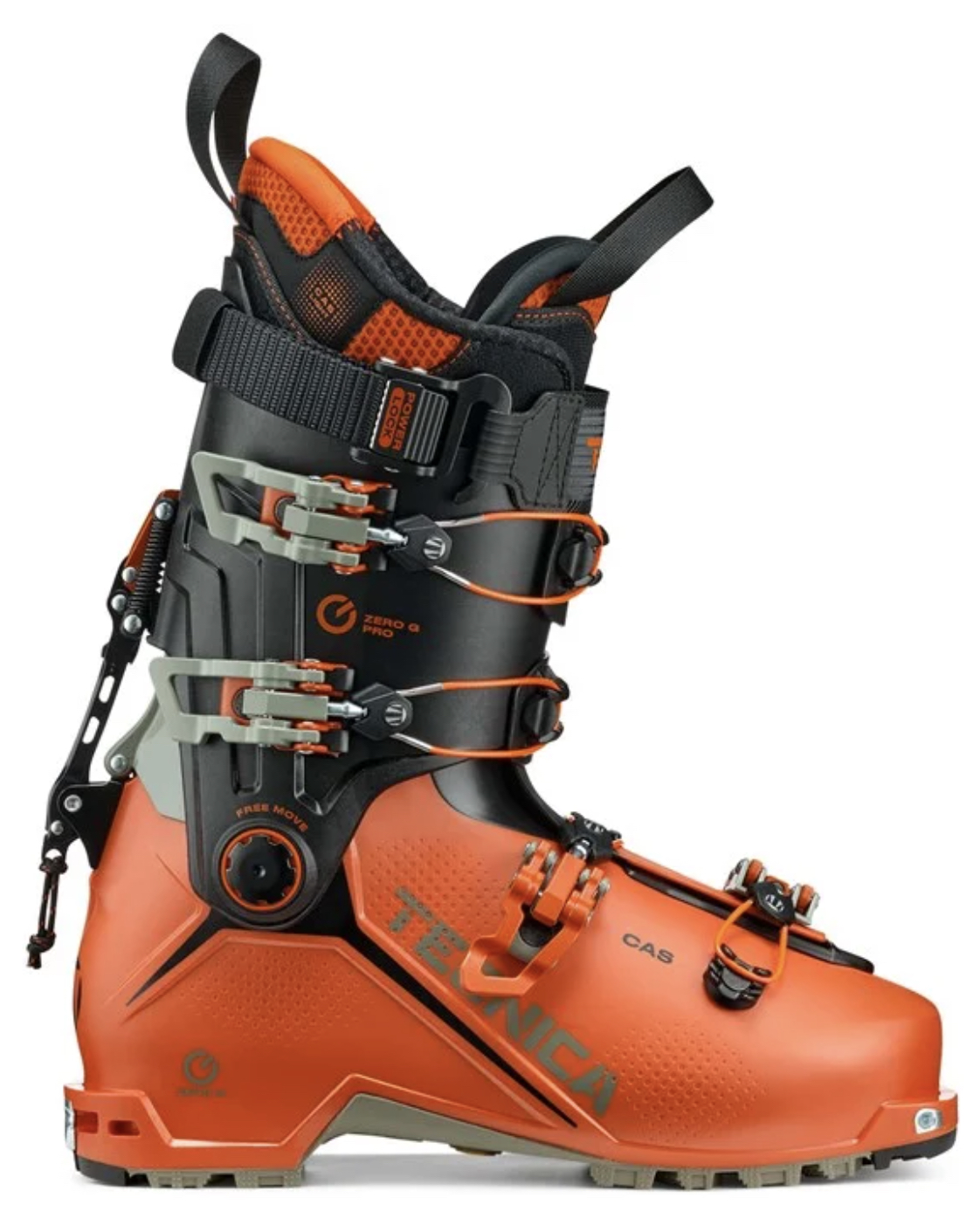 Category: All-around/Freeride
Category: All-around/Freeride
Weight per boot: 1290g
Flex: 130
Other flexes: 105W, 110, 115W, 120, 125W
Range of motion: 60-degrees
What we like: Very lightweight for a stiff, aggressive boot; newly released in a women's model.
What we don't: Not an entry level boot; high price tag.
Tecnica’s Zero G boots are some of the most sought-after designs among committed backcountry riders. The high-end Tour Pro here uses a thin Grilamid shell, and carbon fiber in the cuff keeps it light and stiff. The iconic orange boots have an ultra-secure walk mechanism that connects in two spots when in ski mode. Getting a remodel in 2025, the Tour Pro is 100g lighter, has an improved 60-degree range of motion, and has a higher instep to make getting into them easier. Not to mention, Tecnica all but broke the market this year by offering a women's Zero G Tour Pro in a 125 flex. Overall, the Tour Pro is one of the lightest and stiffest touring boots on the market.
Tecnica trimmed away close to 500 grams per boot in 2024, which certainly is impressive, but we're curious to see how the boot stands the test of time. Comfort also suffers a bit with the minimalist build, and not everyone will like the thin liner. And take note: A 130 flex makes for a solid boot for expert skiers, but this stiff and unforgiving build will overpower those with less experience. If this sounds like you, Tecnica also offers the Zero G Tour Scout ($800) and standard Tour ($700), which have 120 and 110 flex ratings, respectively.
Read more: women's Tecnica Zero G Tour Pro W review
See the Men's Tecnica Zero G Tour Pro See the Women's Tecnica Zero G Tour Pro W
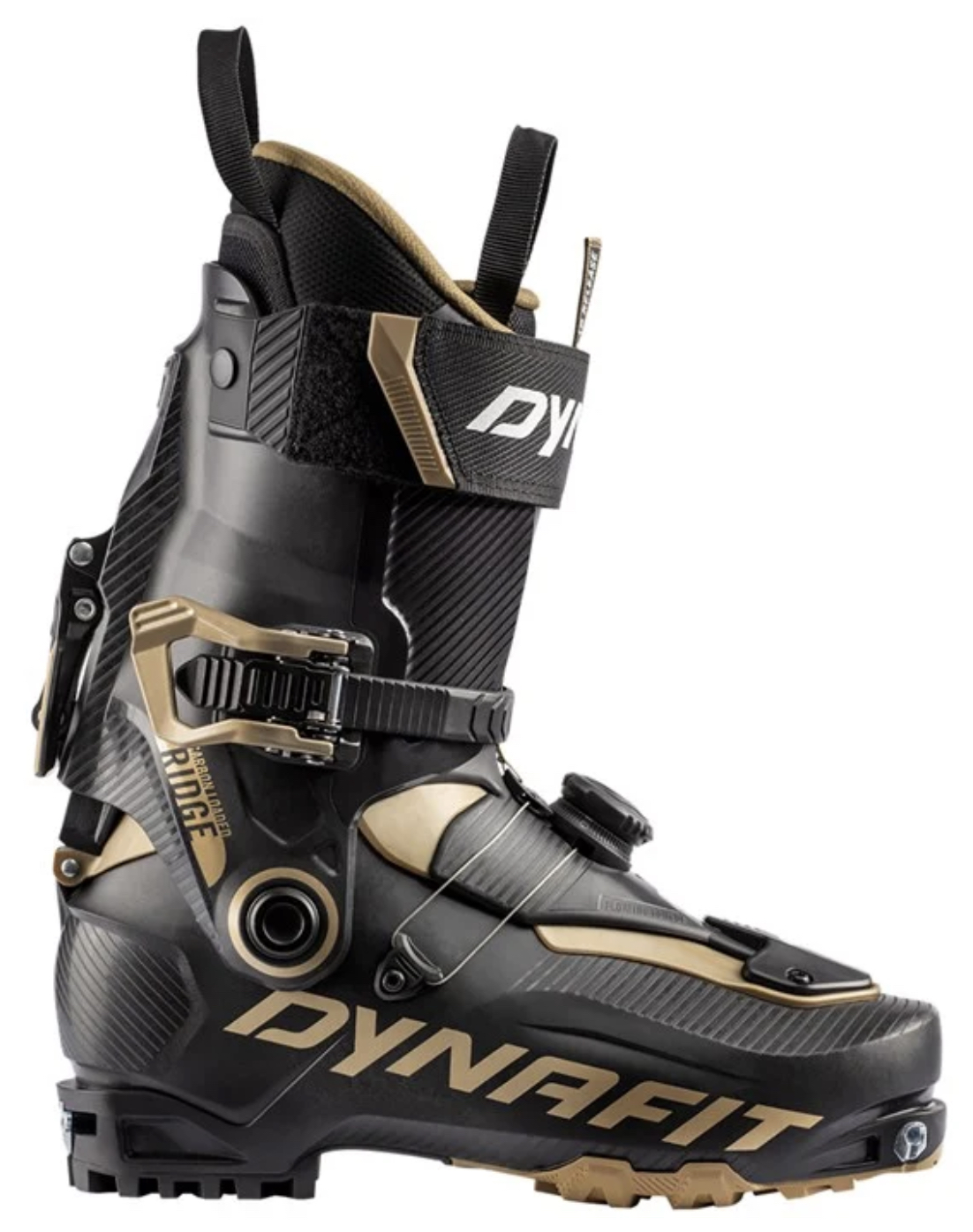 Category: Lightweight/Freeride
Category: Lightweight/Freeride
Weight per boot: 1250g
Flex: 120
Other flexes: 100W (Not Pro), 110W, 110 (Not Pro)
Range of motion: 70-degrees
What we like: All the performance of the Radical Pro with less weight.
What we don’t: Not as time-tested as Rad Pro or TLT series.
Backcountry freeride master Eric Hoji spent hours tinkering in his garage, and the Dynafit Ridge Pro is the happy result. This boot promises all the downhill performance of the elder Radical Pro ($800) but with even less weight. Coming in a 120 flex in the men's and a 110 flex in the women's, initial testing notes show the single BOA closure does the job of the Rad Pro's two buckles. This saves on weight while adding a more customizable and tailored fit. Blending the Grilamid shell with carbon cuts weight too, making this boot a trusty companion on long missions where downhill performance matters. There are also slightly less stiff options that will become available in the U.S. later this season.
Some say that the Ridge all but replaces the Radical Pro below and is coming for the TLT X below as more weight is shaved down in future iterations...but we're not so sure. The carbon build of the Ridge takes away weight, but we're curious how this will affect durability compared to the beefy Rad Pro. And the TLT X is essentially in a different class, at 220 grams less per boot with a much different construction (and drastically cheaper price tag). The Ridge Pro is trying to bridge the gap between lightweight and freeride backcountry boots, coming from the freeride side. This is similar to the stiffest boot of the F1 family, the Scarpa F1 XT ($899), which comes from its lightweight brethren. While we're also not huge fans of the stock Dynafit liners, and the carbon makes the Ridge Pro hard to work on, we think this is a promising addition. You'll find us testing them out this winter.
Read more: women's Dynafit Ridge Pro W review
See the Men's Dynafit Ridge Pro See the Women's Dynafit Ridge Pro W
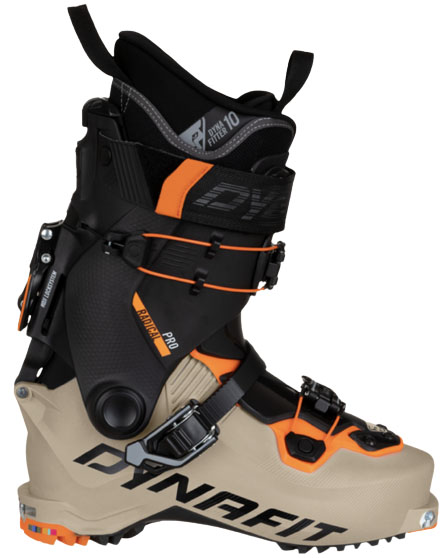 Category: All-around/Freeride
Category: All-around/Freeride
Weight per boot: 1400g
Flex: 120
Other flexes: 100W (not Pro), 110W, 110 (not Pro)
Range of motion: 60-degrees
What we like: A great all-around boot with the ingenious Hoji Lock System.
What we don’t: Stock liners pack out too quickly.
The Radical Pro is the follow-up to Dynafit’s Hoji Pro Tour of the now-beloved Hoji lineup. This boot is fine-tuned for classic ski touring, with a high volume (the 103.5mm is one of the widest here), a 60-degree range of motion in walk mode, and a relatively light weight that will satisfy most recreational skiers. And like its predecessor, the Radical Pro features the innovative Hoji Lock System (which makes transitioning between skiing and skinning a one-step breeze) but replaces the speed nose with a more standard design, resulting in more versatility with a range of crampons. These boots have become fast favorites of guides and snow professionals spending many long days in boots in the backcountry.
The Radical Pro gives our top-ranked Scarpa Maestrale RS a run for its money in most departments but falls short for hard-charging skiers with a less aggressive stance (11˚ forward lean vs. the RS’s 16˚) and a bit softer build. But the Radical Pro, including the women's model, hits a really nice middle ground for the majority of backcountry-goers, particularly those with wide feet. Dynafit also makes the standard Radical ($650) in a 110 flex, also available in a women's 100 flex, which features a more basic PU cuff (rather than the Pro’s fiber-reinforced Grilamid) and drops the Hoji Speed Lock system for a more traditional boot design.
See the Men's Dynafit Radical Pro See the Women's Dynafit Radical Pro
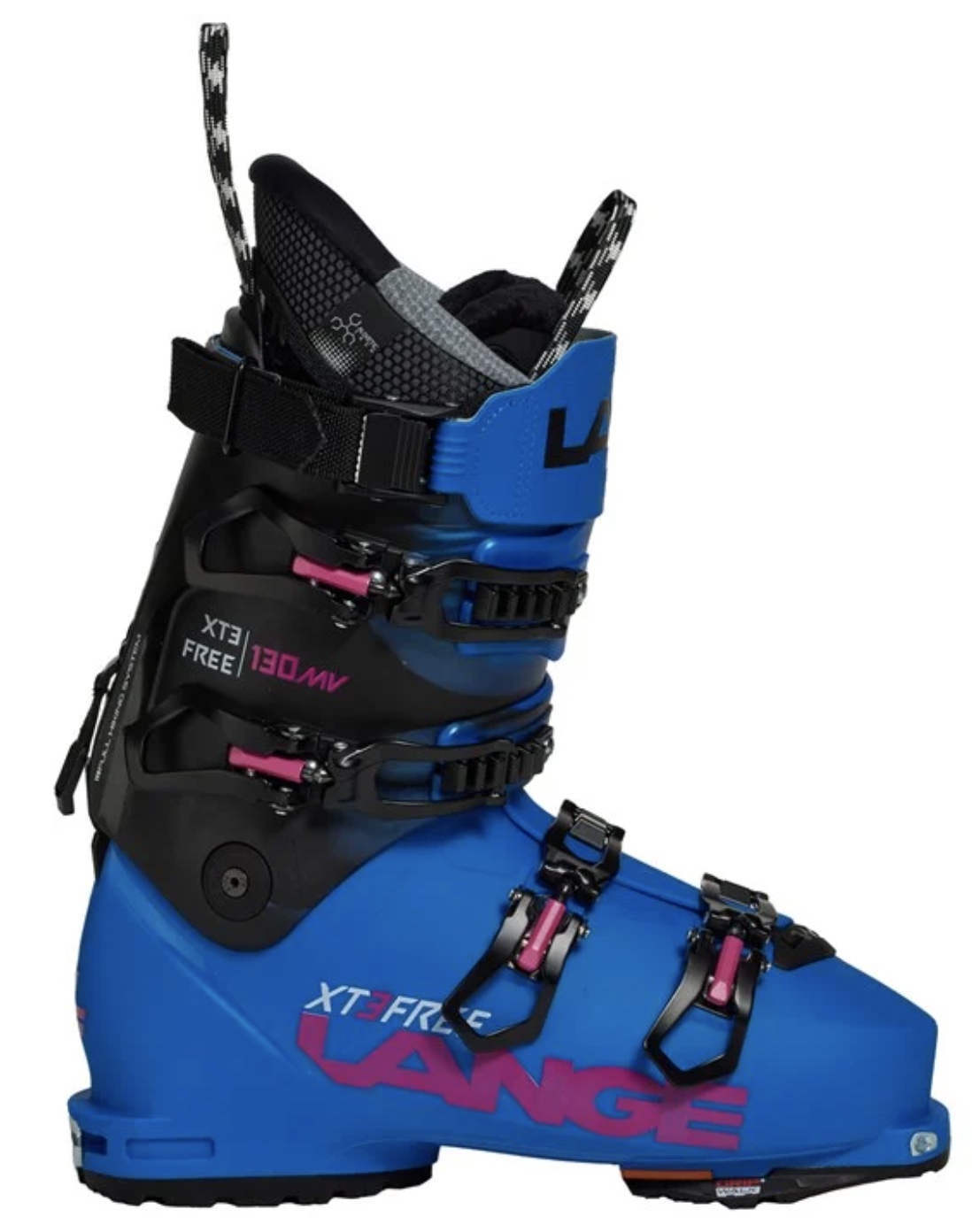 Category: Hybrid
Category: Hybrid
Weight per boot: 1450g
Flex: 130
Other flexes: 95W, 110, 115W, 120, 140 (Pro)
Range of motion: 53-degrees
What we like: The downhill capabilities of an alpine boot with a walk mode.
What we don't: Too heavy for long tours.
On the pendulum of uphill and downhill performance, Lange’s XT3 Free swings decidedly toward the latter. Featuring a strong 130 flex, snug and performance fit from the four-buckle design, and a shell construction that’s shared with their impressive RX downhill boot, the XT3 Free is as confidence-inspiring as it gets when skiing big lines and through variable conditions. But flip the lever into walk mode, and you get a surprisingly good range of motion (53˚ with the latest model), and the GripWalk soles hold their own while hiking. For sidecountry skiers or those who want one boot that can transition between the resort and backcountry, the Lange XT3 Free is a strong option. There are plenty of flex options available for men and women, from the 95 women's to the new for 2025 140 flex Pro.
While Lange stepped up the style in 2025 with some retro colorways, what do you compromise? Most notably, the Lange XT3 Free is one of the heaviest designs on our list at almost 3630 grams (8 lbs.) for the pair, which is significant for those who like the skin track. And while hybrid boots are an undeniably heavy and bulky breed, the similar weight Atomic Hawx Ultra XTD above feels nimbler for longer walks. We weren't super impressed with the XT3's walk mode capability. Regardless, with Lange's performance on the descent and the added ability to choose between flexes and last widths, the Lange XT3 Free is a great match for aggressive riders embarking on the occasional uphill foray.
Read more: Lange XT3 130 review
See the Men's Lange XT3 Free 130 MV See the Women's Lange XT3 Free 115 MV
 Category: Lightweight
Category: Lightweight
Weight per boot: 1030g
Flex: Unavailable
Other flexes: Unavailable
Range of motion: 60-degrees
What we like: Great price, super lightweight and quick to transition, new model has better crampon and binding compatibility.
What we don't: Can’t charge like an alpine boot.
Short for “Tour Lite Tech,” Dynafit’s TLT collection has helped to define modern ski touring as we know it. Updated last season, the TLT X shaves off almost a half-pound from the previous version and brings the pair under 5 pounds total. The new model features a Boa-like lacing system (Dynafit calls it “Twistfit”), which securely snugs the boot around the instep and heel, and the sleek upper buckle both adjusts the cuff and quickly transitions between ski and tour modes. The X also boosts comfort with a wide, 101-millimeter last (in Dynafit’s words, designed for “North American feet”) and an updated Dynafitter 5 boot liner, which is a step up from the minimalist liner of the TLT 8. While the flex is not given a rating by Dynafit, we think it's close, possibly a bit softer, than the Scarpa F1 LT above.
Another noteworthy change with the TLT X is the omission of the “speed nose.” Used in previous iterations, the design maximized touring efficiency but limited binding and crampon compatibility without additional Dynafit proprietary accessories (a pretty annoying feature we're happy is gone). Now with a full toe welt, the X can be paired with automatic crampons and is compatible with most multi-norm bindings. But keep in mind that while the TLT series is a favorite among some of the fast-and-light touring and ski mountaineering crowd, the boot has drawbacks: Relative to its feathery construction, the downhill performance is a bit lacking, can feel harsh, and is more difficult to drive in poor snow conditions. This is why, despite the jaw-dropping $500 price, we still feel the K2 Mindbender above is the better budget buy for most skiers unless you specifically need to drop weight. That said, among the lightweight competition, the TLT X only has competition from the Scarpa F1 LT, making it one of our favorite boots for backcountry skiers covering a lot of ground.
See the Men's Dynafit TLT X See the Women's Dynafit TLT X
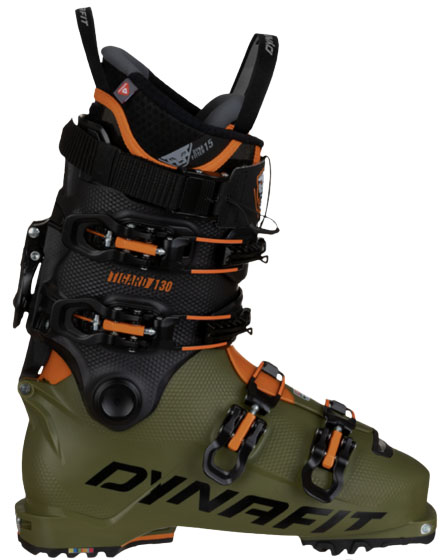 Category: Hybrid
Category: Hybrid
Weight per boot: 1550g
Flex: 130
Other flexes: 110
Range of motion: 70-degrees
What we like: An impressive balance of freeride performance and touring capability.
What we don't: Unless you’re truly splitting your time, other options will save weight.
For the 2025 season, Dynafit is fully leaning into taking frontside performance out of bounds, and the new Tigard 130 is a case in point. Fans of the widely popular Dynafit Vulcan (discontinued several years ago) may find a worthy replacement in the Tigard, a four-buckle boot that boasts a stiff 130 flex and 13 degrees of forward lean. Additionally, an overlapping Grilamid and carbon shell fully wraps the foot in an alpine-style construction, and a quality Primaloft liner boosts warmth on lift-riding days. But it can hold its own as a touring boot, too, with 70 degrees of cuff rotation, Dynafit's unique Hoji Lock System for fast and easy transitions, and a reasonable weight of just 1550 grams per boot.
It's not difficult to make an aggressive ski boot—these are a dime a dozen in the downhill boot category—but the true challenge comes in a hybrid design. For this reason, we're excited to see Dynafit re-enter this space, as the Austrian brand brings a lot of uphill expertise to the table. The Tigard is no exception, with walkability and ease of transition on par with many all-around and lightweight models here (in fact, its listed range of motion is the fourth best on our list). Popular hybrid designs like the Atomic Hawx Ultra XTD and Lange XT3 Free should be shaking in their boots (no pun intended), and we're excited to see how the Tigard fares during more extensive testing. Finally, it's worth noting that Dynafit also offers the boot in a 110-flex version ($700), which will appeal to lighter or less aggressive skiers.
See the Dynafit Tigard 130
 Category: Hybrid/All-around
Category: Hybrid/All-around
Weight per boot: 1500g
Flex: 130
Other flexes: 100W, 115W, 120
Range of motion: 61-degrees
What we like: Lighter than the Atomic Hawx Ultra XTD; downhill performance on par with the Lange XT3 Free.
What we don't: Boot runs a bit small even for the advertised 99-millimeter last.
Another Scarpa boot to make our list is the 4-Quattro XT, their popular hybrid offering. While the F1 LT is a classic amongst fast-and-light skiers and the Maestrale RS is an incredible all-arounder, the 4-Quattro XT sits at the top of Scarpa’s lineup as an aggressive true hybrid boot for the downhill-focused crowd. On the descent, the Quattro is a true beast even inbounds, with a stiff 130 flex that we found rivaled the Maestrale, and a four-buckle design that offers a confidence-inspiring ride. On the other hand, it’s relatively light for a hybrid boot (1500g per boot) and features an impressive 61-degree range of motion. The compatibility of the sole with GripWalk alpine bindings makes this Scarpa's clear hybrid offering. The Quattro XT is also available in a women's version, and a softer flex SL-version ($769) both for the ladies and for men.
The 4-Quattro XT has been one of our top choices for resort and lift-accessed backcountry skiing, giving our top hybrid pick, the Atomic Hawx Ultra XTD above, a run for the money. But while the Scarpa is currently the lightest GripWalk boot in its class, it does make some compromises. The boot is fairly slim-fitting—an “old-school alpine, crush-your-feet kind of feel” in the words of our, albeit not daintily-footed tester—although on paper, the 100-millimeter last is fairly standard (we sized up and were happy with the fit). If you have a high-volume foot, you might be better off in the true 101-millimeter last Dynafit Tigard 130 above. All told, the 4-Quattro XT is an exciting new entry from one of the best in the business and should be high on the list for the hybrid crowd.
Read more: Scarpa 4-Quattro XT review
See the Men's Scarpa 4-Quattro XT See the Women's Scarpa 4-Quattro XT
 Category: Lightweight
Category: Lightweight
Weight per boot: 1162g
Flex: 110
Range of motion: 74-degrees
What we like: Impressive range of motion with high advertised flex for aggressive downhill skiing.
What we don't: Lightweight build compromises durability and dampness in rough snow.
At 1162 grams per boot, the Atomic Backland Carbon is among the lightest boots on our list and a solid choice for uphill-focused skiers with downhill demands. Combining a 74-degree range of motion with a relatively stiff 110 flex, the Backland is on par with the Scarpa F1 LT and Dynafit TLT X in terms of mobility, although it doesn’t quite measure up in terms of weight. And with a recent update, the boot is now easier to transition: Atomic did away with the removable tongue stiffener—an innovation that proved too cumbersome in use—and instead built downhill stiffness into the spine. There's also a washable 3D Platinum Tour Liner to help lengthen the life of the boot after absorbing an ultramarathon's worth of sweat during your day tour.
Atomic ditched the Boa lacing system and the buckle-and-cable system and revamped the liner to make it more resistant to packing out. These updates added a few ounces to the boot’s weight, but it's still aiming for the same category as the F1 LT and TLT X. That said, with all the new tech, we have slight concerns about the boots’ long-term durability, although we’re happy to see metal used for the top buckle. Carbon always saves weight but makes boots harder to work on. Still, these are fairly common concerns for lightweight boots, and the Backland’s combination of weight, mobility, and downhill performance make it a very appealing option.
See the Atomic Backland Carbon
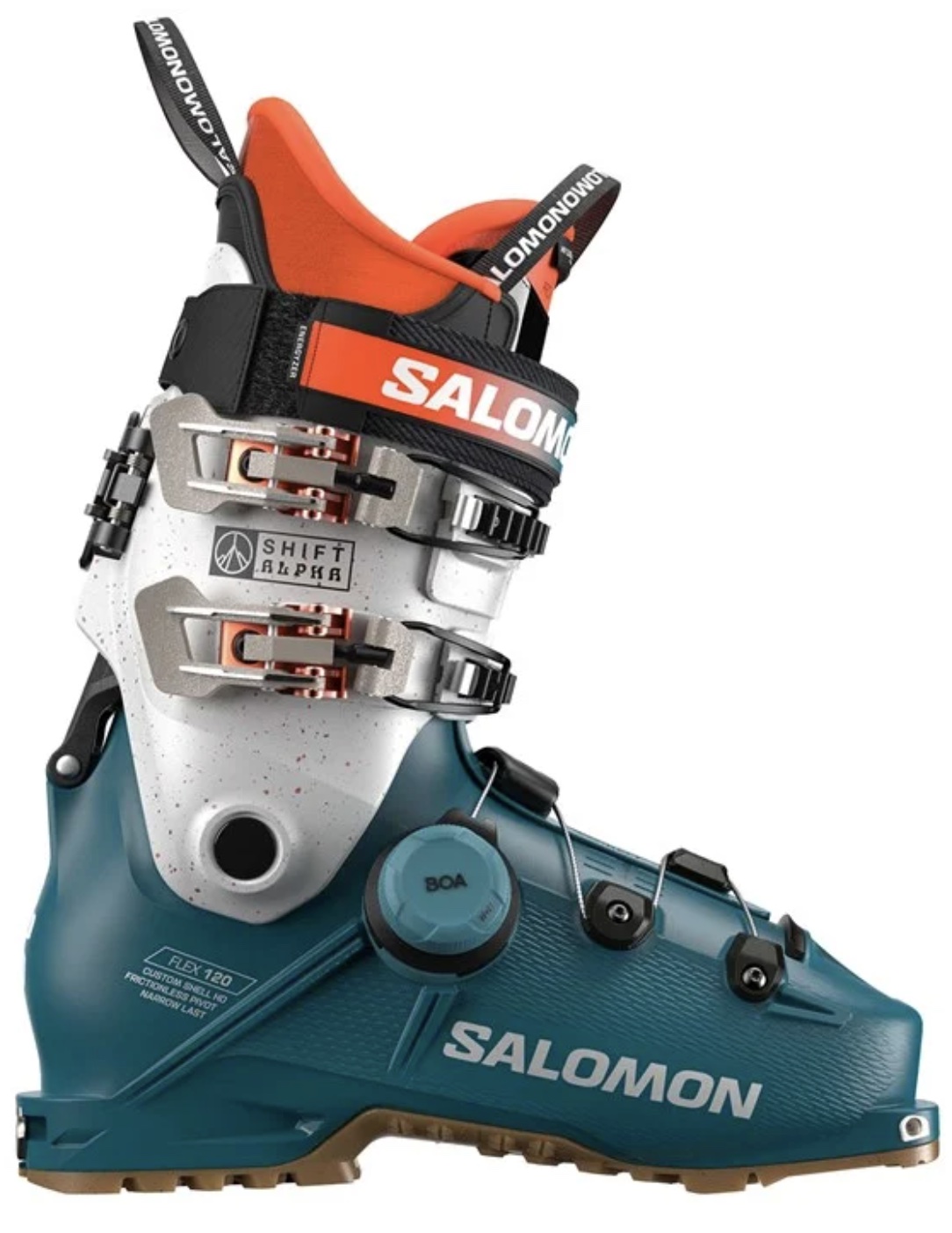 Category: Hybrid
Category: Hybrid
Weight per boot: 1750g
Flex: 120
Other flexes: 95W, 110, 115W, 130
Range of motion: 55-degrees
What we like: Alpine boot-like design and performance, big improvement from Shift Pro.
What we don’t: Relatively limited range of motion.
As a companion to the Shift binding and a follow-up to their standout Shift Pro model that appeared on this list last year, Salomon has released their Shift Alpha this year. The hybrid design targets downhill-oriented riders with traditional alpine boot features like a two-buckle and beefy Boa layout, sturdy shell, and a warm liner. The fit is among the most customizable on our list thanks to Salomon’s Custom Shell HD, which is shared with the brand’s popular S/Pro resort boot and allows for extensive heat molding. Additionally, the Boa on this model ups the ante for a closer fit. On the uphill, the Shift Alpha checks the right boxes with an easy-to-access hike lever, tech inserts, and GripWalk soles for reliable traction.
Who is the Salomon Shift Alpha best for? With its powerful and sturdy build, the design caters more to the resort crowd that mixes in the occasional half-day tour. While 26g grams lighter than the Shift Pro ($700), switching into tour mode gets you a relatively limited freedom of movement—the 55-degree range of motion is a huge step up from the Shift Pro's 43-degrees, but falls short of other boots on our list. That said, if your climbs aren’t especially steep or you don’t mind sacrificing some efficiency, the Salomon’s resort-inspired construction has a lot of appeal among skiers who like to charge both on- and off-trail.
See the Men's Salomon Shift Alpha BOA 120 See the Women's Salomon Shift Alpha BOA 115
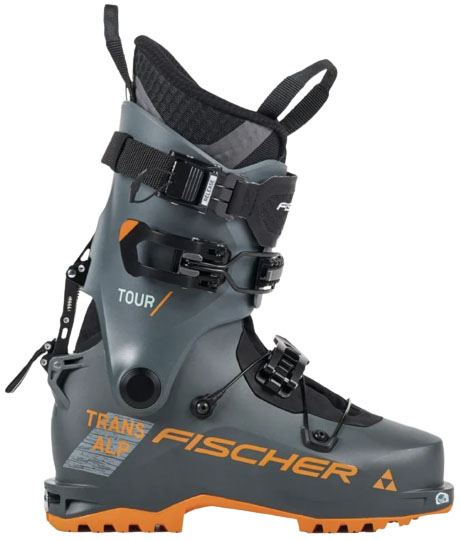 Category: All-around
Category: All-around
Weight per boot: 1280g
Flex: 110
Other flexes: 100, 110W
Range of motion: 80-degrees
What we like: Sustainably made Pebex Rnew shell and 80-degree range of motion.
What we don’t: Not as stiff as the Maestrale RS above.
Back for its third season, Fischer’s Transalp lineup features two ski touring designs: the Tour (men's and women's) and the entry-level TS. These boots slide right into our all-around category, with equal focus on both uphill and downhill performance. And the headliner is the Pebax Rnew shell, which is sustainably made from 65% castor oil (a natural and degradable alternative to plastic). Not only that, but Pebax is thought to be more durable and responsive than Grilamid, a standard material in designs like the Zero G Tour Pro above. Added up, the Transalp is another solid contender for backcountry-goers looking for a boot that’s as fun on the skin track as it is in the powder stashes.
At just under 1300 grams per boot, the Transalp Tour is a bit lighter than our chart-topping Scarpa Maestrale RS, and it also comes with the added benefit of an 80-degree cuff rotation, which is the best of any boot in our lineup. Taken together, this means that the Fischer offers slightly better performance on the uphill. But the tradeoff comes in flex—while the Maestrale RS clocks in at 125, the Tour receives a “stiff” rating that is decidedly not as progressive as the Scarpa’s. On the other hand, it’s a nice bump up from a lightweight model like the F1 LT or TLT X above. Backcountry skiers are always walking that fine line between uphill and downhill performance, and the new Transalp Tour is another high-quality and well-balanced option.
See the Men's Fischer Transalp Tour See the Women's Fischer Transalp Tour
 Category: All-around/Freeride
Category: All-around/Freeride
Weight per boot: 1634g
Flex: 130
Other flexes: 110, 120
Range of motion: 60-degrees
What we like: An impressive 60˚ range of motion in walk mode.
What we don't: Not as light as the competition, liner is tough to get on and off, no women's Pro version.
K2 has always done well with their downhill-focused hybrid collection (see the Mindbender 100 above), but the Dispatch Pro ups the tech to achieve better uphill performance without compromise. They even go so far as to classify the Dispatch line as “freetour”—a blend of freeride and touring—which is a bold claim. But everything about the Pro seems to back it up: The boot balances a 60-degree range of motion with a stiff 130 flex rating while checking in just over 1600 grams per boot. Fine-tuning the fit is as easy as twisting the Boa adjustment dia, though this tech does make the boot rather hard to get on and off. Finally, with a 100-millimeter last and heat-moldable shell and liner, the Dispatch Pro should be a comfortable pairing for most feet. Not to mention, the Boa Tourfit Liner allows you to dial that fit even closer.
Along with the Pro here, the Dispatch collection also includes a more intermediate friendly boot (the standard Dispatch) and the lightweight Dispatch LT ($800). The standard Dispatch features a flex of 110 and purposefully retains the feel of an alpine boot, which makes it a great pick for those just beginning their transition from the resort. On the other hand, the LT prioritizes weight-savings with a 120 flex and sub 1700 gram build. For the weight, these boots can’t quite match the downhill performance of designs like the Scarpa Maestrale and Tecnica Zero G Tour Pro, but the Pro does have a competitive range of motion (60˚ compared to the Scarapa and Tecnica’s respective 61-degrees and 55-degrees). Time will tell how the Dispatch line fares in a competitive market, but it’s certainly a solid entry from a well-respected brand.
See the K2 Dispatch Pro
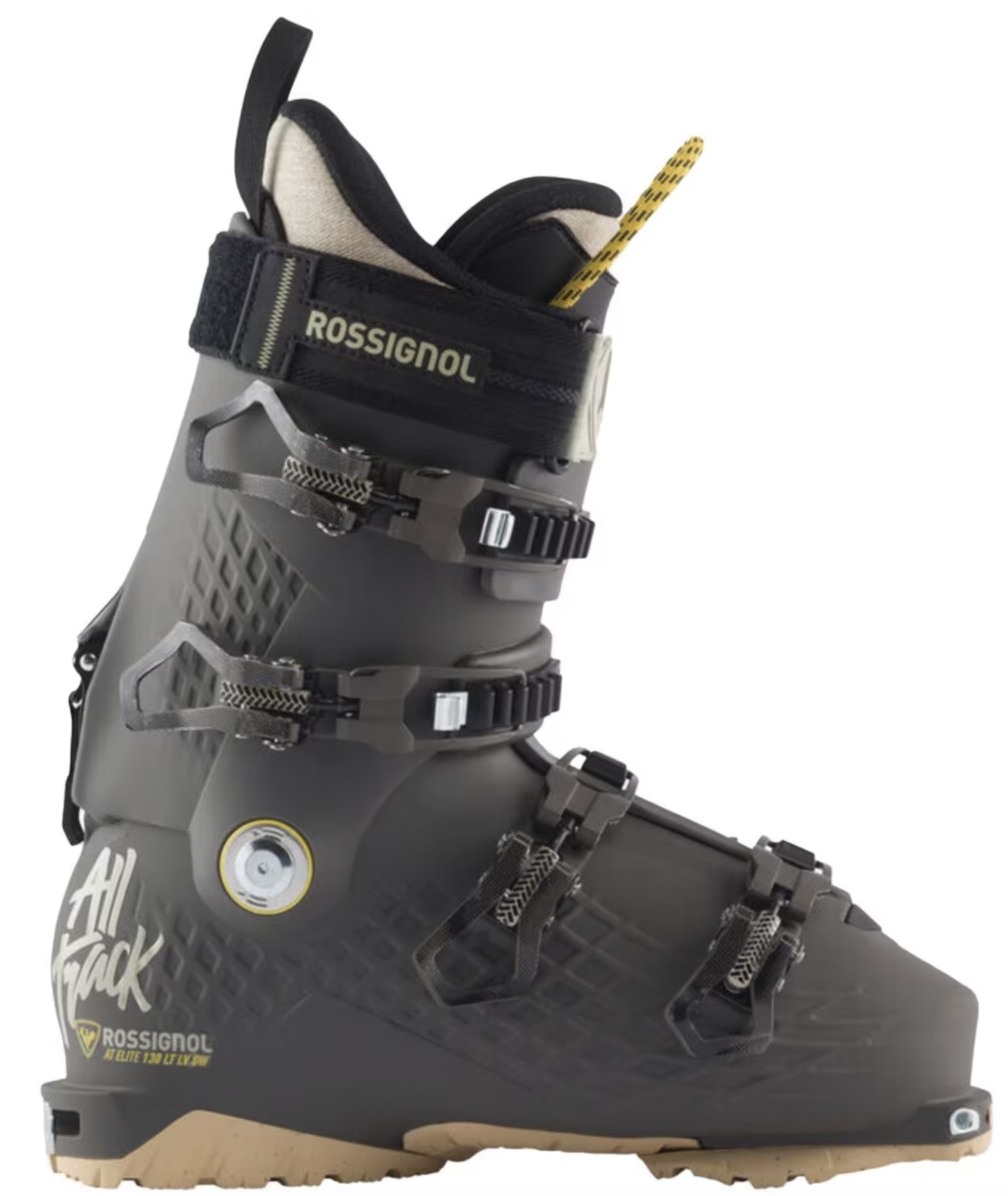 Category: Hybrid
Category: Hybrid
Weight per boot: 1740g
Flex: 130
Other flexes: 80W, 90, 90W, 110W, 110, 120
Range of motion: 50-degrees
What we like: Like the Lange XT3 Free, the Alltrack is confidence-inspiring on the descent.
What we don't: Heavy and fairly limited range of motion.
Rossignol's Alltrack Elite is built for those who aren't ready to bid farewell to their loyal resort skis and bindings. While in ski mode, the Alltrack Elite feels like a true alpine boot: It has an aggressive stance, four sturdy buckles, and the shell is stiff but precise. Additionally, the GripWalk sole makes it easy to swap between touring and resort setups (provided you have modern bindings), and the Thinsulate-filled liner offers sufficient warmth for season-long use. Its narrow 98-millimeter last might not work for all foot shapes, but the Alltrack Elite is well-equipped for hard chargers that like to take on ambitious side- and backcountry lines.
With the Alltrack's emphasis on downhill performance, you inevitably give up some of the seamless walkability of a dedicated backcountry boot. Rossi’s hike mode and more traditional buckle system simply can’t match the ease of use and freedom of movement that you get with Scarpa’s Maestrale or Dynafit’s Radical Pro above. And among sturdy freeride-oriented models, the Lange XT3 Free has a little better range of motion and climbing comfort. But the Rossignol remains a well-made, versatile boot overall, and there's real value in being able to use it interchangeably at the resort and in the backcountry.
Read more: Rossignol Alltrack Elite 130 LT review (prior version)
See the Men's Rossignol Alltrack Elite 130 See the Women's Rossignol Alltrack Elite 110
| Boot | Price | Category | Weight/Boot | Flex | ROM | Last |
|---|---|---|---|---|---|---|
| Scarpa Maestrale RS | $949 | All-around | 1460g | 125 | 61˚ | 101mm |
| K2 Mindbender 100 | $600 | Hybrid | 1796 g | 100 | 50˚ | 100mm |
| Atomic Hawx Ultra XTD 130 BOA | $950 | Hybrid/All-around | 1831g | 130 | 54˚ | 98mm |
| Scarpa F1 LT | $949 | Lightweight | 990g | 100 | 72˚ | 100mm |
| Tecnica Zero G Tour Pro | $900 | All-around/Freeride | 1290g | 130 | 60˚ | 99mm |
| Dynafit Ridge Pro | $900 | Lightweight/Freeride | 1250g | 120 | 70˚ | 101mm |
| Dynafit Radical Pro | $800 | All-around/Freeride | 1400g | 120 | 60˚ | 103.5mm |
| Lange XT3 Free 130 | $850 | Hybrid | 1450g | 130 | 53˚ | 100mm |
| Dynafit TLT X | $500 | Lightweight | 1030g | Unavail. | 60˚ | 101mm |
| Dynafit Tigard 130 | $800 | Hybrid | 1550g | 130 | 70˚ | 101mm |
| Scarpa 4-Quattro XT | $869 | Hybrid/All-around | 1500g | 130 | 61˚ | 100mm |
| Atomic Backland Carbon | $850 | Lightweight | 1162g | 110 | 74˚ | 98mm |
| Salomon Shift Alpha BOA 120 | $850 | Hybrid | 1750g | 120 | 55˚ | 98mm |
| Fischer Transalp Tour | $800 | All-around | 1280g | 110 | 80˚ | 100mm |
| K2 Dispatch Pro | $900 | All-around/Freeride | 1634g | 130 | 60˚ | 100mm |
| Rossignol Alltrack Elite 130 LT | $850 | Hybrid | 1740g | 130 | 50˚ | 98mm |
Skiing is a favorite activity for many of the editors at Switchback Travel, and our team runs the gamut of experience levels. From those who are relatively new to those who have been skiing since they could walk, we know how to assess and recommend the right gear for all skill levels. This guide was kicked off in 2019 as a group effort, until freelance writer and gear tester Alli Hartz took over as the manager in 2022. Working with senior editor Jenny Abegg, the two pieces together a well-organized splay of top picks from every part of the backcountry market. Based in Bend, Oregon, Alli shares her love for skiing through teaching avalanche courses and ski guiding in the winter months. Jenny calls Leavenworth, Washington home and loves to get up in the mountains any way she can, whether by fastpacking in the summer or skinning up in the winter. Contributing editor Brooke Maushund took over this guide in 2024. A lifelong lover of all things snow, Brooke has served as a ski patroller, guide, avalanche educator, observer, and avalanche forecaster in the snowpacks of Idaho, Patagonia, Washington, and the Eastern Sierra. Collectively you couldn't ask for a better crew to outline the best backcountry ski boots on the market.
Our current lineup of sixteen pairs of backcountry boots above is the result of ongoing testing, feedback from our freelance testers, and extensive research. Given the rapidly growing amount of offerings for backcountry boots, we’ve included a relatively wide variety of options, varying in last, flex, and use cases. To make our list, each boot had to stand out in one or more areas, with many striking an effective balance between performance, use, and durability. If you're looking to complete your setup for 2025, know we took a similar approach with our lineup of touring skis and backcountry bindings.

Backcountry ski boots, otherwise known as AT (alpine touring) boots, are designed specifically for use in areas with no chairlift access. They differ from standard downhill (alpine) models in a few ways, the most notable of which are binding compatibility and uphill capability. Whereas a downhill ski boot typically is only compatible with an alpine binding that keeps both the heel and toe locked in at all times, a backcountry ski boot is used with a touring-specific binding that secures the toe and allows you the option of freeing the heel of the boot for uphill travel on skis.
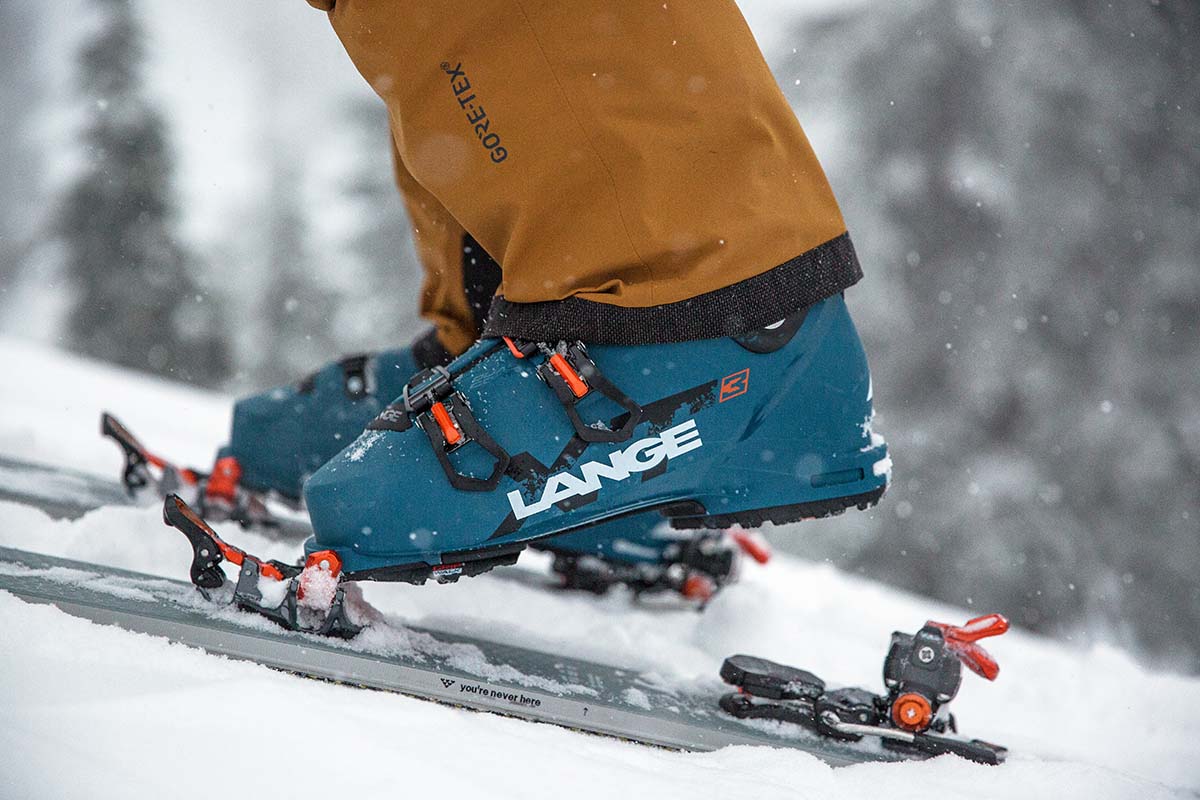
In order to travel uphill, backcountry ski boots also feature a walk mode, which allows the boot to pivot at the ankle with each stride. In the vast majority of cases, this is toggled via a lever along the spine of the boot. While in walk mode, you get a sufficient range of motion for skinning and boot packing, differing in amount and comfort by boot model. Locked into place, the boot resembles a standard downhill design with enough stiffness to transfer power to the bindings and skis. The competing demands of weight and flexibility on the climb (and therefore comfort and natural movement) with stiffness and control on the descent means alpine touring boots are complex and incorporate high-end materials like Grilamid, Pebex Rnew, and carbon fiber. This leads to expensive price tags that often exceed $800, but a quality design that fits your feet well can be an amazing companion for exploring the backcountry.
Most ski brands want you to believe that their backcountry gear compromises nothing on the uphill or downhill. In a perfect world, an alpine touring boot would be both lightweight and flexible on the uphill and stiff and supportive when bombing down steep terrain. We don't live in a perfect world, however, and although some boots come close, the reality is that you'll always be sacrificing a bit of downhill prowess for uphill comfort—or vice versa. As a result, we've put backcountry ski boots into four general categories: "all-around" for boots that try to achieve that elusive all-in-one solution for backcountry demands, "lightweight" for those that prioritize climbing efficiency and low weight above all else, "hybrid" for those that feature alpine-worthy downhill performance and are advertised for in-bounds use as well, and "freeride" to reflect the increasingly diverse set of needs among hard-charging backcountry riders. Below, we break the styles down in greater detail.
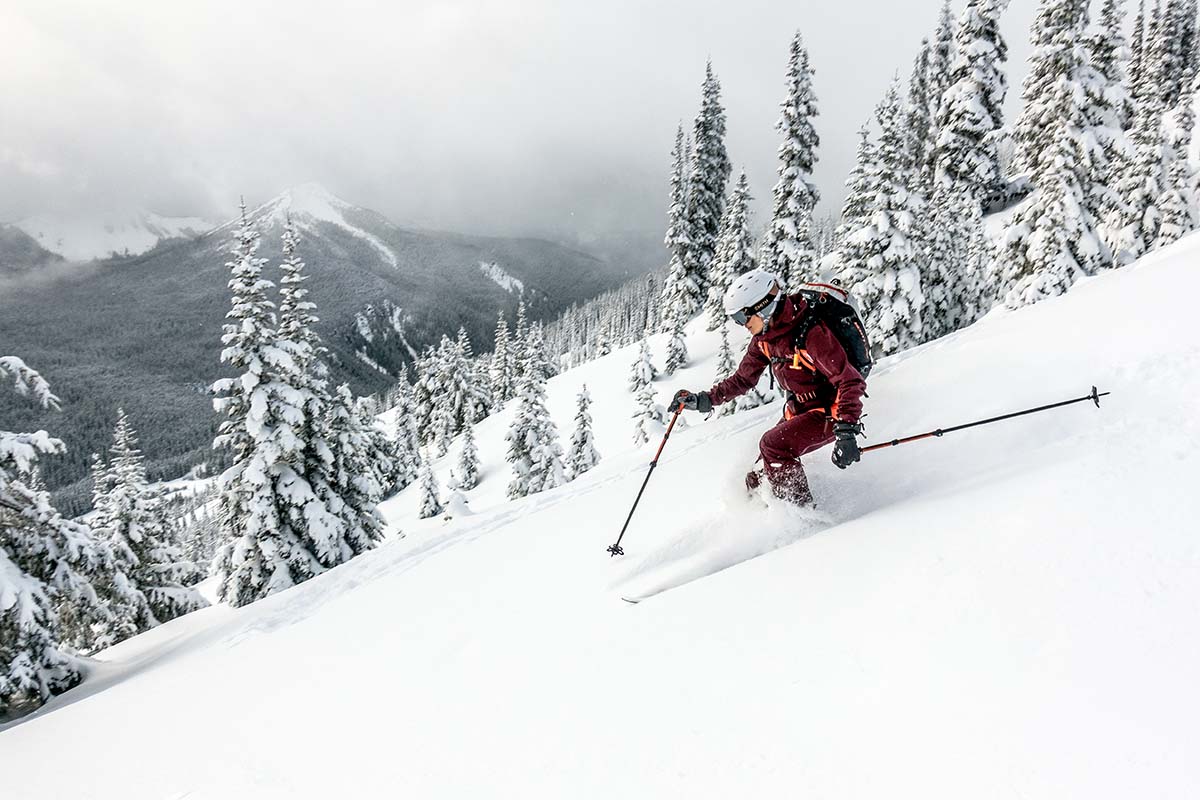
All-Around
Our all-rounder category is home for standard touring designs that meet all the needs of a typical day of skiing in the backcountry: You're probably not attempting to set any FKTs (Fastest Known Times), but your ascent is likely completely human-powered. For this healthy mix of downhill and uphill, you need a boot that can excel at both—that proverbial perfect world. Alpine touring boots are characterized by this balance, with lightweight builds, a high range of motion in walk mode, a stiff ski mode, crampon and tech binding compatibility, and grippy soles. A boot like the Scarpa Maestrale RS (and women's Scarpa Gea RS) is able to pull off all of these features. This best-of-both-worlds scenario tends to warrant a higher price tag, but for folks who seek a true backcountry experience with big ups and big downs, it's worth the investment.

Lightweight
More than any other style of touring boot, lightweight designs for ski mountaineering or deep backcountry exploration prioritize uphill travel. They are characterized by a minimalist build, high range of motion (often both lateral and vertical), minimal buckles and weight, crampon compatibility, tech binding fittings, and grippy soles. The low weight and increased range of motion of these boots (as well as typically softer flex) can make skiing down feel a little insecure, especially on icy or hard-packed terrain. Thus, these boots are perfect for long days in the mountains when uphill travel or long mileage is the goal, but they're certainly not for frequent use in bounds. The Scarpa F1 LT and Dynafit TLT X are two of our favorite lightweight boots.
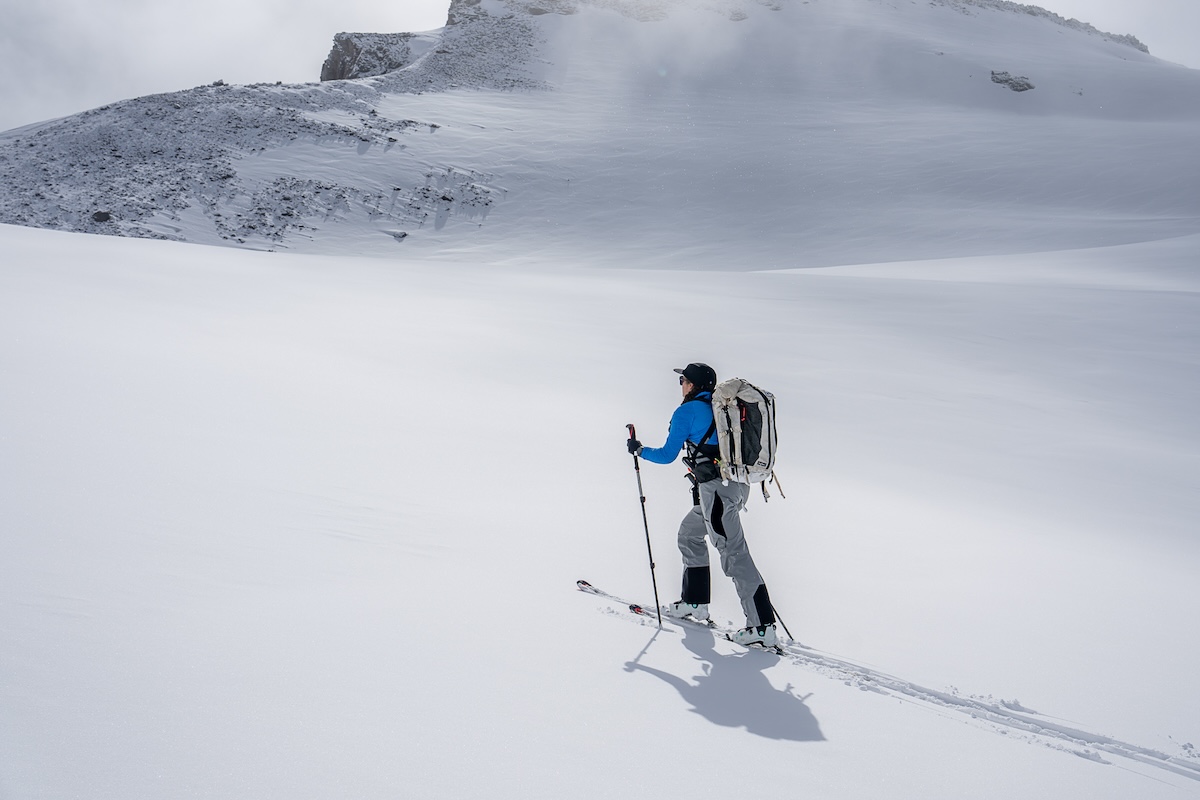
Hybrid
In skiing, the word “hybrid” refers to a piece of gear that bridges the gap between the resort and the backcountry (the term “50/50” is also commonly used). A hybrid boot is an ideal option for backcountry-curious resort skiers who want the option to ski out-of-bounds from time to time (the backcountry terrain adjacent to the resort is often referred to as the sidecountry). Because the sidecountry often necessitates far less uphill travel than other forms of backcountry skiing, an ideal hybrid boot will prioritize stiffness and stability on the downhill over uphill comfort and weight savings. You'll see an increase in weight, bulkier designs, less range of motion, four buckles, a slightly more forward lean, and compatibility with alpine bindings. Hybrid boots also excel for aggressive skiers who want a burly and reliable option for big-mountain backcountry adventures with mechanized access using a snowcat or helicopter, though these types of skiers may also start to be interested in the newly emerging category of freeride backcountry boots. Options like the Lange XT3 Free 130, Rossignol Alltrack Elite 130 LT, and Dynafit Tigard 130 fit squarely into this category.

Freeride
While the hybrid category used to encapsulate both the hybrid and freeride use cases for touring boots, times are a-changing. With more highly developed technology and both professional and homegrown darkhorse athletes pushing what can be done on skis deep in the mountains as much as they are in-bounds on the Freeride World Tour, a new category of backcountry-specific boots is now emerging. These boots are meant explicitly for the backcountry but are also meant for skiing fast, going big, and stomping the landing. These boots won't promise compatibility with downhill bindings like hybrid boots and will have better walkability and uphill design. Boots like the Dynafit Radical Pro fit this category well—they will still excel on the downhill but don't expect them to be as good of hiking companions as lightweight boots like the Scarpa F1 LT.

The weight of a ski boot makes a huge difference for comfort and maintaining energy throughout a day in the mountains. Whereas the typical weight of an alpine ski boot design can hover around a hefty 5000 grams (11 lbs.) per pair, an average backcountry model weighs around 2750 grams (just over 6 lbs.) and can drop as low as below 1000 grams (2.2 lbs.) for a ski mountaineering setup. If traveling uphill comfortably and efficiently is the goal—without overly compromising on the descent—there are a number of excellent options in the 2270 to 3200-gram range. For short tours or strong riders who prioritize downhill performance (including sidecountry enthusiasts), you should have approximately 3700 grams (about 8.2 lbs.) or under for your pair as a good benchmark, but as always, the market continues to evolve with better performance options coming out at lower weights. But when you creep above that point, uphill travel can become an uncomfortable and overly exhausting activity for the average skier.

The flex rating describes how much pressure must be applied to flex your boot forward at the ankle while in ski mode. A lower number means the boot is softer, while a higher number means the boot is stiffer, and you'll find numbers ranging from 70 at the low end for a super soft beginner alpine boot up to 130+ for an expert model. It's worth mentioning that there isn't a standardized test to establish these ratings—it's up to the manufacturer to list them. This means flex ratings are not exactly created equal amongst different manufacturers, but for the most part, we've found the flex rating to be a helpful tool (and we call out any boots that don't seem to match their given rating in the write-ups above). With downhill boots, typically less experienced skiers will prefer a boot on the soft side, while advanced skiers will want the power transfer and stability of a stiffer boot. Beginners should understand that although a softer flex in a downhill boot generally means it is for newer skiers, softer flex touring boots are not aimed at the same market. The Scarpa F1 LT is a great example here. With a 95 flex rating to save weight on far-reaching backcountry pursuits, the F1 LT is not going to be a good match for a beginner to intermediate skier, while the downhill-specific K2 BFC 95 (same flex) would be perfect.
To reiterate: Backcountry ski boots tend to be less stiff than alpine boots for a number of reasons. First, backcountry skiers are more likely to seek out powder than hard snow—and powder doesn't require as much power transfer as hardpack. Additionally, touring boots are typically manufactured with lighter materials, which makes them softer in general. Because of this, a backcountry ski boot's flex rating won't always translate perfectly to the flex rating of an alpine ski boot (for example, a backcountry boot with a stated flex of 110 might feel slightly softer than an alpine ski boot with the same given flex number).

Below are some very general recommendations for ski boot flex based on ability level; however, it is important to note that there is no recommendation for beginner skiers. While we are all for inclusivity and think everyone has a place in the backcountry (eventually), if you are truly a beginner skier, you need time at a ski resort learning to move downhill in a controlled environment before going out of bounds. There are so many pieces of knowledge on top of gear to operate to just get by on a basic day in the backcountry—avalanche danger, avalanche rescue skills, techniques to manage variable conditions, terrain management, etc. You need to at least be confident in your ability to get downhill safely to be able to have enough bandwidth to manage all of the other essential parts of a day of being in the backcountry.
Intermediate: 90-110
Advanced: 100-120
Expert: 120+
More recently, there has been a push by many ski gear manufacturers to offer a range of flex options for individual boot models, allowing the user to choose the perfect stiffness for their level, weight, and ankle flexibility. For example, the Atomic Hawx Ultra XTD is available in 100, 120, and 130 flex ratings for men, and the women’s version has 95 and 115 variations. Further, you’ll see prices rise as flex ratings increase, due to the more premium materials and design of a stiffer boot. When applicable, we’ve made mention of the various flex options available for each boot in the individual write-ups above.
You've likely heard the phrases "earn your turns" or "you've gotta get up to get down." However you choose to say it, backcountry skiing is just as much (if not more) about the uphill as it is about the downhill. If you're truly touring—not using lifts for accessing the sidecountry—then you'll spend somewhere around 75% of your time on the uptrack. For this reason, all backcountry ski boots are designed with two modes: a walk mode (increased range of motion for uphill travel) and a ski mode (stiff and supportive for descents). Each boot has a way of locking into ski mode or releasing into walk mode, usually by way of a lever on the back that engages and disengages with a flip.
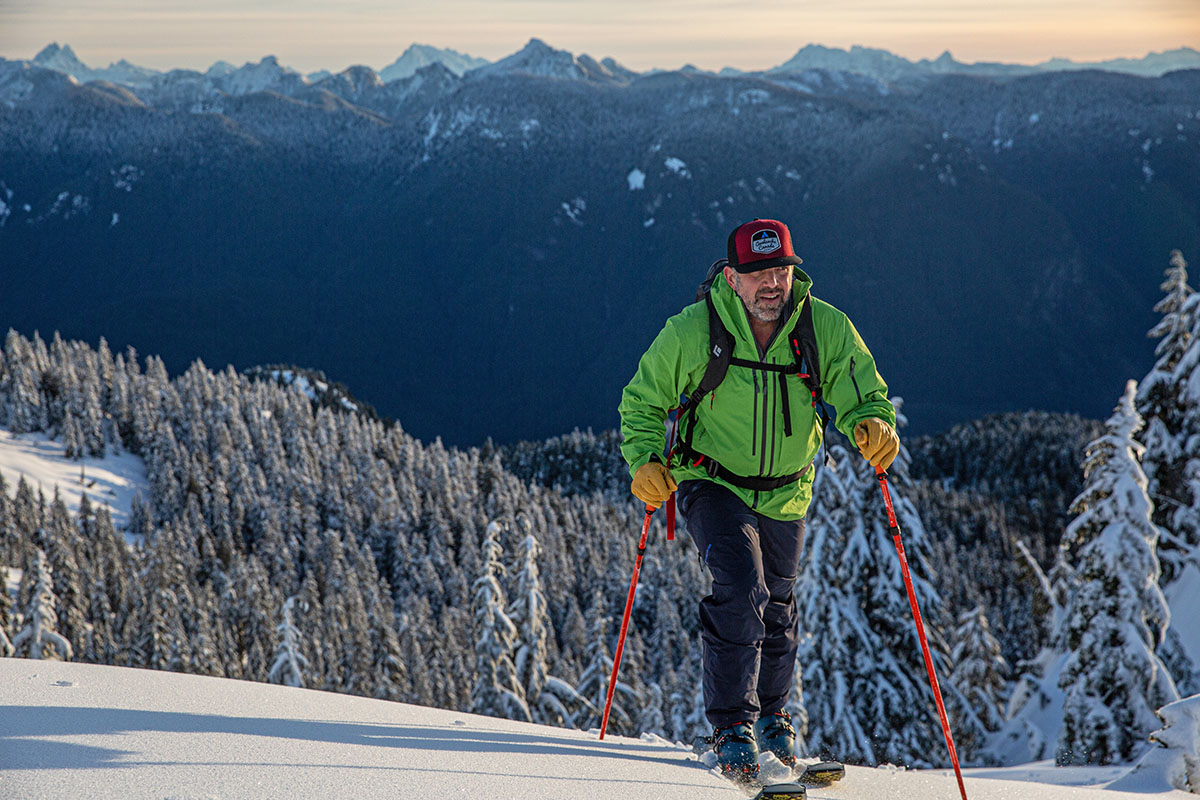
Walk mode and range of motion go hand-in-hand: This specification describes the amount of fore/aft motion available in a ski boot while in walk mode. The range of motion (ROM)—also known as cuff rotation—is defined by a few factors, namely the materials used in the design of the boot and the amount of play these materials are allowed. But it's important to note that soft materials and a high range of motion create inherent weakness in the structural integrity of a boot. Thus, while boots with a greater range of motion will be more comfortable on long ascents, they aren't able to provide as much support on the descent as a boot with harder materials or lower cuff rotation.

The range of motion specification is a good number to pay attention to when thinking about how much of your ski day will be uphill-focused. If you are more interested in full days in the mountains with big ups and long traverses, a greater range of motion like what you get with the Scarpa F1 LT (72˚ total forward/backward) will help preserve energy in your legs, get the most out of each stride, and will be more comfortable in general. If the goal is long, potentially steep descents, and you aren't feeling confident in softer boots like a pro skimo racer, opt for a boot that sacrifices range of motion for a higher flex rating. Boots such as the Scarpa Maestrale RS (61˚) and the Dynafit Tigard 130 (70˚) offer a good mix of both.

Buckles are yet another place where manufacturers can make decisions that affect the uphill vs. downhill performance of a boot. Whereas a standard alpine ski boot has four buckles, a backcountry boot can have anywhere from two to four. Fewer buckles mean less weight, which is certainly helpful for uphill travel. However, fewer buckles also mean you'll sacrifice power and rigidity on the descent. Skiers more interested in uphill travel can get away with a boot with fewer buckles, while skiers more interested in making solid downhill turns will feel more confident with three or four buckles. Additionally, most backcountry-specific ski boots are manufactured with a removable "power strap," which is a thick piece of Velcro near the top of the cuff. This strap adds significant support for aggressive downhill skiing, particularly on harder snow. However, since it also adds weight and is not needed for uphill travel, some manufacturers prefer to remove the strap altogether.

In terms of buckle design, most boots are built with a classic aluminum buckle with a ladder and catch bail, but more and more we're seeing different configurations and technologies. Many recent innovations allow for more support without more ounces. The Scarpa Maestrale RS, for example, combines two buckles with one strap for a lightweight setup that spreads pressure out along the entire top of the foot. Other boots use a Boa buckle closure to hone in fit with a simple twist, like the Dynafit Ridge Pro. No matter the closure system, it is important to practice buckling, unbuckling, and adjusting your boots before heading into the mountains. You'll likely be dealing with your buckles a lot as you transition from uphill to downhill and vice versa, and you'll want to be efficient when temperatures drop and the wind starts howling.

Perhaps the single most important aspect of a ski boot is how it fits your foot. We highly recommend trying on multiple pairs before purchasing, as every manufacturer builds boots with a specific shape that will fit some feet better than others. The main challenge will be finding the ideal balance of a snug yet comfortable fit. If it's too roomy, a boot will not offer the needed support for downhill skiing. If sized too tight, it will (at best) be uncomfortable during long days in the mountains, but more likely, it will cut off circulation and create dangerously cold feet. If you're transitioning from alpine skiing to alpine touring, keep in mind that you'll want to size your boot a bit looser than you might be accustomed to. With little opportunity to take your boots off throughout the day and the need to skin or hike uphill, you'll want to prioritize comfort and a good fit above all else.
Mondopoint
Ski boot size is delineated by the Mondopoint—aka-Mondo-scale—which refers to the length of your foot in centimeters. You can measure your own Mondo size quite easily by putting your foot against the wall, marking where your toes end, and measuring the distance in centimeters. Most ski boot shells are built only in full-size increments, whereas liners come in half sizes. If you're a Mondo size 25.5, for example, you'll get a size 26 ski boot shell with a size 25.5 liner. You can use a conversion chart to determine your Mondo size but we still highly recommend getting fitted by a ski boot professional.
.jpg)
Last
Whereas a boot's Mondo size refers to the length of the foot, the last refers to the foot's width in millimeters. Many traditional alpine ski boots are available in two to three different lasts to accommodate various foot sizes, but backcountry ski boots don't usually offer this option. Because of this, when shopping for a boot, you'll want to make sure you choose a model made with a last that fits your individual foot. Those with wider or higher volume feet should look for boots with lasts 100 millimeters and up, and those with narrower feet will be happy with a last between 95 and 98 millimeters. Again, it's worth repeating that this information is good for planning purposes but can't come close to the value of getting fitted by a reputable ski shop.
Customization
Like their alpine counterparts, most touring boots can be customized through heat molding, punching, grinding, etc. In most cases, the liners can be heat-molded, which we prefer to do at our local ski shop. But because alpine touring boots are intended for extended time on your feet—walking, gliding, possibly kicking in steps, skiing, and some standing around during transitions—you’ll want to try to start out by choosing boots that are fairly comfortable right out of the box. Hard-to-fit feet may require some customization, but if your touring boots require extensive work, you might be better off with a different pair altogether. We recommend working with a professional boot fitter, trying on multiple pairs of boots before purchasing, and getting any customization done at a ski shop with the proper equipment.
Most ski boots are technically unisex, but some manufacturers have chosen to offer touring models specifically for female skiers. Some of these have different monikers—for example, the women's version of the Scarpa Maestrale RS is called the Gea RS—while most go by the same name. The question is: What are the differences between a women's and men's ski boot?

In reality, there are not as many differences as you might think. Women's boots have graphics that may (or may not) have more marketing power for the female ski community. In addition, women's boots usually come in smaller sizes (for instance, the Scarpa Gea RS starts at a size 22.5, while the Maestrale RS starts at 24.5). But most importantly, many women's-specific boots have lower flex ratings that make them softer. All of this assumes, of course, that women prefer different graphics, have smaller feet, and want softer boots—which is certainly not always the case. Some women are quite aggressive and want stiffer flex boots for the backcountry, and slowly the market is catching up to the ladies' capabilities with touring boots like the Tecnica Zero G Tour Pro, a 125 flex women's specific touring boot.
The bottom line is that each ski brand makes its boots with a unique shape, fit, and features. The men's and women's models embody the distinct qualities the brand aspires to offer. If you identify as a female and have found the perfect pair of boots that only come in a men's model, try them on, and don't be afraid to go for it (and vice versa). As long as they feel snug and comfortable, they'll provide you with the backcountry ski experience you're looking for. While body weight and ability affect the flex of the boot you should be skiing, other factors like ankle flexibility (women often have more flexible ankles) also factor into this selection.

A backcountry ski boot is designed with both an outer shell and an inner liner. The shell is responsible for structure, while the liner is built to conform to the foot and provide both comfort and warmth. Most boot liners are a classic slip-on with a forward tongue, while some have a lace or Boa closure for added support. Finally, some liners do not have a tongue at all. In general, the type of liner you choose comes down to how secure and adjustable you like your boot to feel.
One of the most important features of a boot liner is the foam that is sandwiched between the shell and inner lining. On the budget end of the spectrum are open-cell foam designs, which are comfortable at first but tend to pack out quickly. They also take some time to dry, which can make for an extremely cold day as your sweat starts to freeze. On the other hand, some premium offerings include a more expensive closed-cell foam liner—for example, the Intuition Pro Flex Tour in the Scarpa Maestrale RS. These liners keep their shape and cushioning much longer than those of the open-cell variety. What's more, they dry very quickly and tend to keep your feet warmer, even during the coldest days. If your ski boots come with an open-cell foam liner, we have found it to be worth the price (especially for those who run cold) to buy a closed-cell foam liner separately.
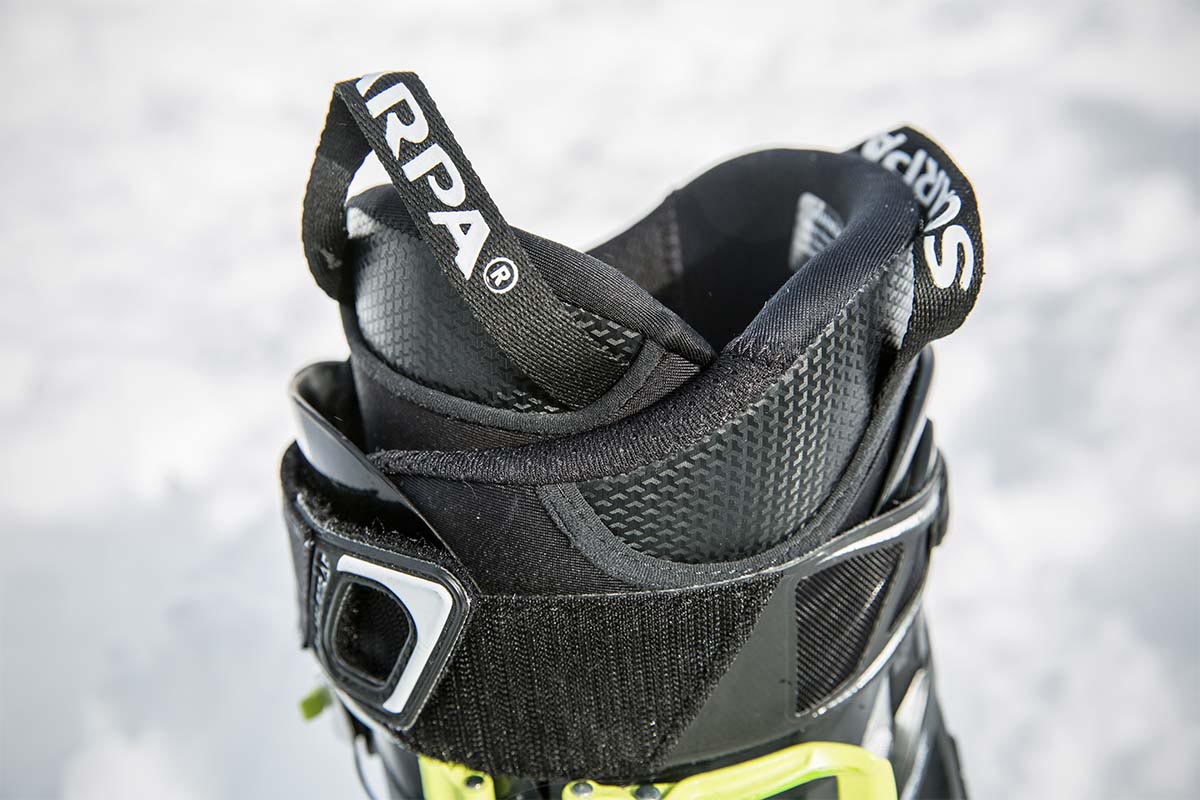
One final note regarding insoles: Most ski boots, whether made for alpine or alpine touring, contain a thin piece of foam in the bottom of the liner. When you’re spending a good portion of your day on your feet, especially when it involves walking, the factory insole that comes with your boot will not provide sufficient support for your arches and foot muscles. Investing in a pair of quality insoles (such as Superfeet) will go a long way in adding comfort, reducing foot fatigue, and contributing to a better fit within your boot’s insole.
This is about as intricate of a topic as you can get into while pairing your backcountry setup, which is why we wrote an entire ski boot binding and compatibility guide about it. There are three categories of backcountry ski bindings: tech, frame, and hybrid (you can read more about the pros and cons of each in our article on tech vs. frame bindings). The style of boot you choose will influence which binding you'll pair it with, and vice versa. Tech bindings, otherwise known as pin bindings, are the most common form of backcountry ski binding. These designs are also the lightest of the bunch (most versions range from 1000 to 1400g for the pair), feature separate heel and toe pieces, and are only compatible with boots that have tech fittings at the toe. Due to their lightweight builds and pivot point near the ball of the foot that allows for a natural stride, tech bindings are our first choice for skiers who spend most of their time in the backcountry and especially those who want to move efficiently uphill. Downhill performance ranges from serviceable to very good, depending on the specific binding.

Frame bindings are essentially traditional downhill bindings attached to a rail that extends from heel to toe. This rail attaches and releases from the heel, allowing for both uphill and downhill movement. Importantly, frame bindings don’t require boots to have tech fittings, which means you can get away with using an alpine boot with a walk mode. The most notable compromise with frame bindings is uphill performance: They are very heavy (weighing anywhere from 1600 to almost 3200g), and the placement of their pivot point in front of your toe results in an unnatural stride and reduced efficiency on the skin track. With more capable tech and hybrid designs on the market than ever before, frame bindings are at risk of becoming obsolete and aren’t our first choice for most skiers. That said, if you’re on a strict budget or ski mostly inbounds, a frame binding could be the best option.
This brings us to the third category (also the newest): hybrid bindings. Hybrid backcountry bindings are really defined by two key designs: the Salomon S/Lab Shift 2.0 MNC and Marker Duke PT. Along with an alpine heel, these bindings feature a toe piece that functions like a tech toe on the uphill but converts into a traditional downhill design when in ski mode. This means a few things: For one, you get incredible downhill performance and safety with a fully locked-in toe, on par with a standard alpine binding (both the Salomon and Marker are TÜV-certified for DIN). Second, hybrid bindings are incredibly versatile in terms of boot sole compatibility: You can wear your tech boots to seek out remote powder stashes (a pin toe is required for uphill travel) or strap in your alpine boots for a day at the resort. They’re heavier than tech bindings (the Shift is almost 1820g, while the Duke PT clocks in close to 2730g), but they’re the least compromised option for skiers who split their time between the front and backcountry and want to use the same setup in both environments.

The ski boot sole discussion is actually a continuation of the binding compatibility dialogue above. In other words, the boot sole is another determining factor of what bindings will fit your boot. This certainly is one of the more complicated topics surrounding backcountry ski boots, especially as technology continues to change so dramatically—hence our decision to put together a boot and binding compatibility guide. That said, it's very important to have a general understanding here and, at the least, have the wherewithal to check that your boots and bindings are compatible before you buy.
Let's start simply: An alpine (resort) ski boot sole (referred to as ISO 5355) is flat on the bottom and only compatible with corresponding ISO 5355-ready bindings (often frame style). A touring boot sole (ISO 9523) is rockered (similar to the bottom of a boat) to allow for a more natural gait. It also has sticky rubber on the bottom, which comes in handy for walking or kicking steps in snow. These boots, such as the Atomic Backland Carbon, are only compatible with tech bindings.
%20Ski%20Boots%20(Rossignol%20Alltrack%20Elite).jpg)
Now there is a third option. In the last few years, Salomon and Marker have created new technologies—Walk-to-Ride (WTR) and GripWalk (GW)—that allow a boot to be compatible with both frame bindings and tech bindings. Boots with WTR or GripWalk technology are not quite as rockered as tech-only boots, yet not totally flat like an alpine boot. Most of these boots are made with tech fittings as well. Many other companies have followed suit, leading to popular boots such as the Atomic Hawx Ultra XTD, which can be used with tech bindings, tech toe/alpine heel bindings, GripWalk frame bindings, and MNC bindings (see below). Thus, one pair of boots can now be used with multiple ski setups (resort setup, alpine touring setup, etc.) without the pain of swapping out bindings or having incompatible combinations.
It's important to note that not all alpine (non-touring) bindings are WTR or GripWalk compatible. If you are interested in using your backcountry boots with your downhill setup, it's definitely worth double checking whether or not your bindings are WTR or GripWalk certified. Furthermore, new MNC (Multi Norm Compatible) bindings from Marker and Salomon take away the guesswork—they simply are compatible with pretty much every style of boot. Very few boots and bindings are labeled MNC (Salomon’s S/Lab Shift2 MN binding is one standout), but it is a strong indication of where the market is headed.
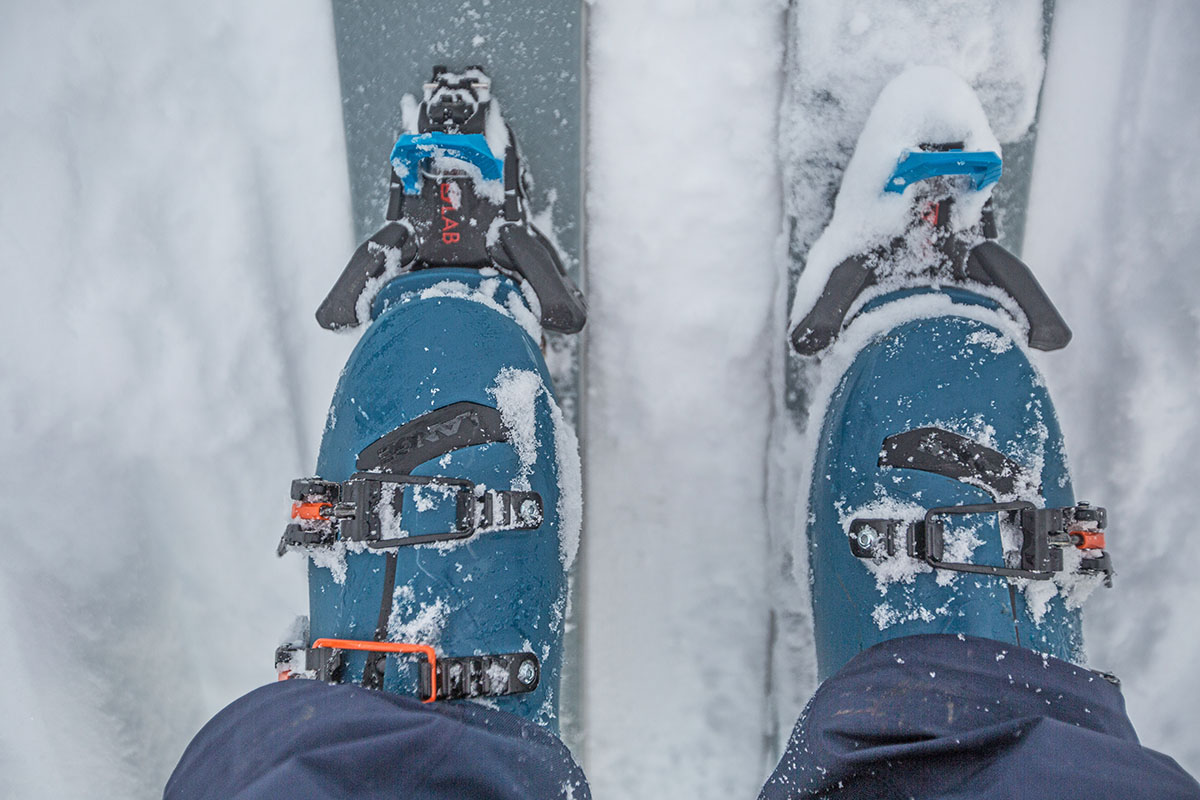
When choosing a pair of boots, it's important to think through the style and performance level of your entire ski kit, including your skis and bindings. Starting with alpine touring skis, you'll want to make sure to match the flex of your boots with the stiffness of your skis. There is no rubric for this, but generally, boots with a higher flex rating (115+) should be paired with stiffer skis, and vice versa for boots with a lower flex rating. A pair of soft skis can feel overpowered by a stiff boot like the Maestrale RS, which can lead to a disconnected and insecure feeling while descending. Alternatively, it is never fun to feel as if you can't turn your skis while using a pair of boots that flex too much.

In addition, your ski bindings play a key role in performance. Like boots, the binding options fall into general categories of lightweight, all-around, and downhill-focused. Light and fast travelers will want a minimalist design like the Dynafit Superlite 175. The Salomon MTN Pure is an excellent all-rounder option, and the Salomon S/Lab Shift MNC has a lot of appeal for those splitting time between the resort and backcountry. Most importantly, as we covered in detail above, you'll want to make sure your boots and bindings are compatible with one another. For more information, including our top picks, be sure to see our article on the best backcountry ski bindings.
Back to Our Backcountry Ski Boot Picks Back to Our Backcountry Boot Comparison Table